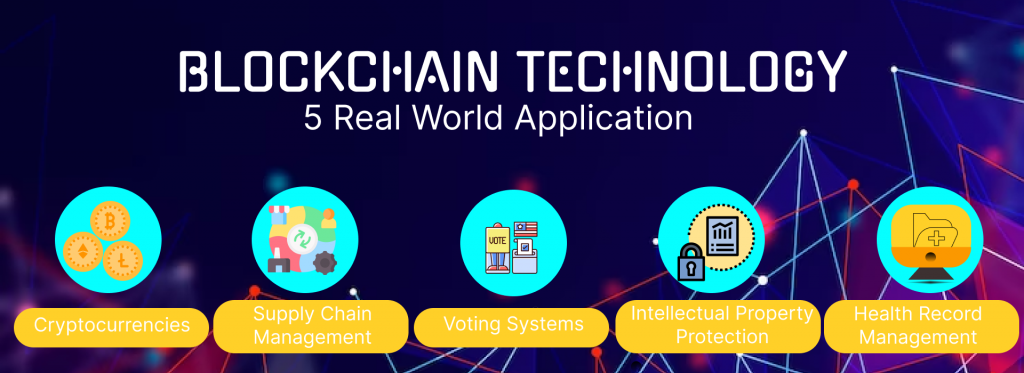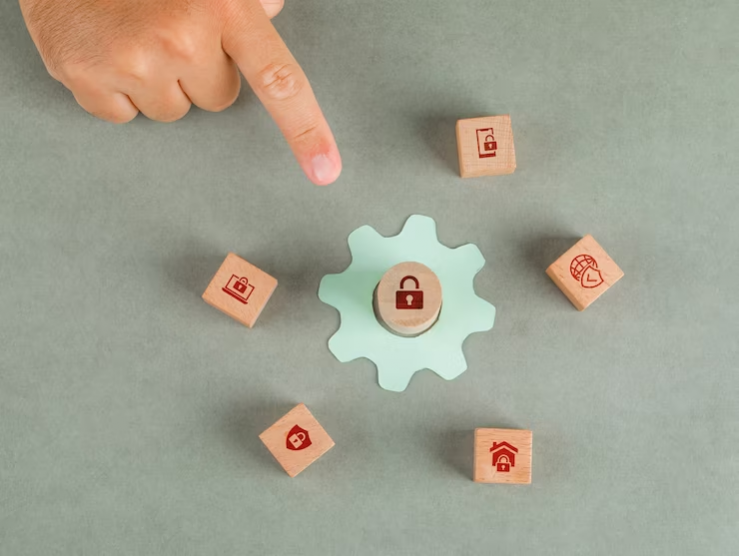"Top 5 Real-World Applications of Blockchain Technology"

It is a revolutionary invention that has the potential to transform numerous industries. Here are the top 5 real-world applications of technology:
Read More: Understanding the Basics of Blockchain
Cryptocurrencies
Cryptocurrency is a digital or virtual currency that uses cryptography for security and operates independently of a central bank. Cryptocurrencies use a decentralized system called blockchain technology to record and verify transactions, which makes them secure and transparent. The most well-known cryptocurrency is Bitcoin, but there are many other cryptocurrencies such as Ethereum, Litecoin, and Ripple.
Unlike traditional currency, cryptocurrencies are not physical and are not backed by a government. Instead, they are based on complex mathematical algorithms that regulate the creation of new units and verify the transfer of funds. Transactions using cryptocurrencies are usually anonymous, and they offer low transaction fees and fast processing times.
Cryptocurrencies are often used as an investment or trading tool, and their value can be highly volatile. Many people see them as an alternative to traditional currencies and a way to bypass traditional financial institutions. However, due to their unregulated nature and the potential for misuse, they have also been associated with illegal activities such as money laundering and terrorism financing.

Supply Chain Management

Supply chain management involves the coordination and management of the flow of goods, services, and information from the point of origin to the point of consumption.
Blockchain technology has emerged as a powerful tool for improving supply chain management by increasing transparency, security, and efficiency. By using technology, supply chain managers can create a decentralized, tamper-proof ledger of all transactions within the supply chain, from raw materials to finished products.
It also enables more efficient communication and collaboration between suppliers, manufacturers, distributors, and customers.
For example, a retailer using technology can trace a product back to its source, identifying the exact farm or factory where it was produced.
Voting Systems
Voting systems based on blockchain technology are a new and innovative way to conduct secure, transparent and tamper-proof elections. In a blockchain-based voting system, voters use a digital wallet to cast their vote, which is recorded on a decentralized, tamper-proof ledger called a blockchain.
This ledger is transparent and publicly available, so anyone can verify that the votes have been recorded accurately and that there has been no tampering with the results. Once the voting period is over, the blockchain automatically tallies the votes and the results are published for all to see.
One of the key benefits of using technology for voting systems is that it eliminates the need for centralized authorities, such as government bodies or election committees, to oversee the process. Instead, the blockchain provides a transparent and secure system that is decentralized, meaning that it is run by a network of users rather than a single authority.
This reduces the risk of fraud and corruption, as well as ensuring that the results of the election are not influenced by any single individual or organization. It also allows voters to participate in the process without needing to trust any single authority, thereby increasing transparency and reducing the risk of electoral fraud.
In addition, blockchain-based voting systems can be programmed to include features such as voter identification, eligibility checks, and ballot tracking, all of which can Identity Verification – This Technology can be used to create secure and tamper-proof digital identities. This can be particularly useful for individuals who don’t have traditional forms of identification, such as refugees or those living in developing countries.

Intellectual Property Protection

Blockchain technology can be used to protect intellectual property rights by creating a secure and transparent registry of patents, trademarks, and copyrights.
Intellectual property (IP) protection in this technology refers to the use of blockchain to secure and manage digital assets that are protected by intellectual property laws. This can include any type of digital asset that is protected by copyright, trademark, patent, or trade secret laws.
The technology provides a tamper-proof, decentralized ledger that can be used to track and manage digital assets in a secure and transparent way. By using the technology, creators and owners of digital assets can establish a clear chain of ownership and prove that they are the rightful owners of the assets.
For example, musicians and artists can use this technology to register their copyrighted works and track their use and distribution. This can help prevent unauthorized use of their work and ensure that they receive proper compensation for their creations.
Similarly, companies can use blockchain technology to manage their trademarks and patents, ensuring that their intellectual property is protected and not used without their permission. This technology can also help protect trade secrets by providing a secure platform for sharing confidential information and ensuring that only authorized individuals have access to it.
Overall, intellectual property protection in the technology can help provide a more secure and transparent way to manage and protect digital assets, reducing the risk of theft, fraud, and unauthorized use.
Healthcare Records Management
Healthcare record management involves the secure storage, sharing, and management of patient health information. Blockchain technology has the potential to revolutionize healthcare record management by providing a secure, decentralized, and tamper-proof platform for storing and sharing patient health records.
With blockchain-based healthcare record management, each patient has a unique digital identity and their health records are stored on a decentralized, tamper-proof ledger that is accessible to authorized healthcare providers. The use of technology ensures that patient data is secure, transparent, and can only be accessed by authorized individuals.
This can help improve the quality of care by allowing healthcare providers to quickly and easily access patient records, reducing the risk of medical errors and improving the coordination of care across different providers. Patients also have greater control over their health data, and can choose which healthcare providers have access to their records.
Blockchain-based healthcare record management can also help improve data accuracy and integrity by providing a single source of truth for patient data. This reduces the risk of errors and inconsistencies in patient records, improving the quality of care and reducing the risk of adverse outcomes.
Read More: Blockchain Use Cases in Healthcare

Conclusion
In conclusion, blockchain technology has numerous real-world applications that can transform industries and improve efficiency, security, and transparency. As the technology continues to evolve, we can expect to see even more innovative uses for blockchain in the future.







